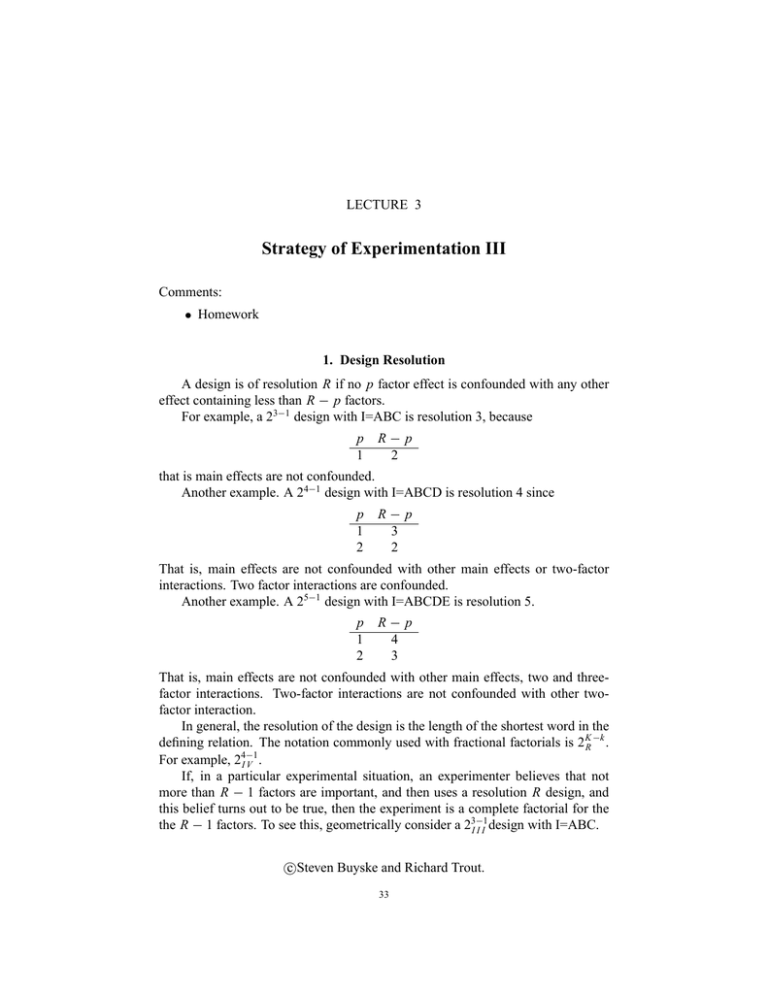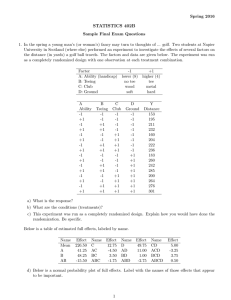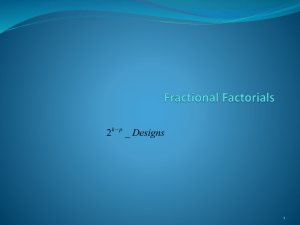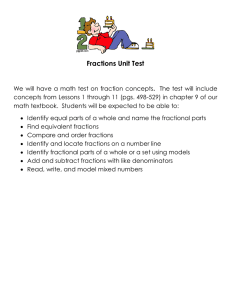Strategy of Experimentation III
advertisement

LECTURE 3 Strategy of Experimentation III Comments: • Homework 1. Design Resolution A design is of resolution R if no p factor effect is confounded with any other effect containing less than R − p factors. For example, a 23−1 design with I=ABC is resolution 3, because p 1 R−p 2 that is main effects are not confounded. Another example. A 24−1 design with I=ABCD is resolution 4 since p 1 2 R−p 3 2 That is, main effects are not confounded with other main effects or two-factor interactions. Two factor interactions are confounded. Another example. A 25−1 design with I=ABCDE is resolution 5. p 1 2 R−p 4 3 That is, main effects are not confounded with other main effects, two and threefactor interactions. Two-factor interactions are not confounded with other twofactor interaction. In general, the resolution of the design is the length of the shortest word in the defining relation. The notation commonly used with fractional factorials is 2 KR −k . For example, 24−1 IV . If, in a particular experimental situation, an experimenter believes that not more than R − 1 factors are important, and then uses a resolution R design, and this belief turns out to be true, then the experiment is a complete factorial for the the R − 1 factors. To see this, geometrically consider a 23−1 I I I design with I=ABC. c Steven Buyske and Richard Trout. 33 34 3. STRATEGY OF EXPERIMENTATION III A B AB (1) c - - + a + b - + ab c + + + we can project into any dimension and have a 22 factorial. C n.s. A n.s . B C A B n.s. In general, any power of 2 fraction of the design can be used: 1/2, 1/4, 1/8, ... . To see how this works, consider a 1/4 fraction of 2 K , i.e., 2 K −2 . Let K = 5, p = 2, so that 25−2 = 8 treatment combinations. Let D=AB and E=AC for the generators. The defining relations are I = AB D I = AC E so I = (AB D)(AC E) = A2 BC D E = BC D E. This means that we have a resolution 3 design. Remark: the number of defining relations of length R is called the aberration of the design. For a given resolution, generally the smaller the aberration the better. We can find the alias pattern by multiplying the “core” 23 factorial by the various relations. 1. DESIGN RESOLUTION I = I I = AB D I = AC E A A(AB D) = B D A(AC E) = C E B AD ABCE AB D BDE C ABCD AE AC BCD E BC ACD ABE ABC CD BE show treatments run to achieve this pattern We can use the other 3 possible fractions, e.g. 35 I = BC D E A(BC D E) = ABC D E CDE ACDE BDE ABDE DE ADE I = −AB D I = AC E I = AB D I = −AC E I = −AB D I = −AC E References for fractions of two-level factorials: C. Daniel, Applications of Statistics to Industrial Experimentation, Wiley, 1976. Box and Hunter, “The 2 K − p fractional factorial designs,” Technometrics (1961), pp311– and pp449–. The original paper on fractional designs is by Finney, “Fractional replication of factorial arrangements,” Annals of Eugenics 12 (1945) 291–301. In general, a 2K − p fractional factorial has p generators and 2 p defining relations (including I ). Each factor is aliased with 2 p − 1 others, and the design has 2 p distinct fractions. For example, p = 1 1 generator 2 defining relations 2 fractions p = 2 2 generators 4 defining relations 4 fractions If R is the resolution of the design then for a 2 K −1 , we have K ≥ R, e.g., . . . . 3 7 For a 2 K −2 , we have K ≥ R, e.g., . . . . For a 2 K −3 , we have K ≥ R. 2 4 36 3. STRATEGY OF EXPERIMENTATION III K−p In general, if we have a 2 R design then R≤ 2 p−1 K. 2p − 1 Where does this come from? Well, the number of relations that a given letter (=main effect) can appear in is (1/2)2 p = 2 p−1 , and there are K letters. On the other hand, there are 2 p −1 relations other than I , and R is the length of the shortest one(s). Thus 2 p−1 K ≥ (2 p − 1)R, which gives the relation above. It is possible, however, that a particular design may not be attainable. 1.1. Augmenting fractional designs. After a fractional design has been run, many times the question arises how to supplement the design points. Lots of work has been done on this subject. To give you some ideas along these lines, consider the following situations. With resolution III designs the main effects are confounded with two-factor interactions. Suppose that a factor from the first experiment looks interesting. The factor may be “de-aliased” by running a second fraction in which the sign of the variable has been switched. For example, suppose we run a 25−2 I I I design with D = AB and E = BC, giving I = AB D I = BC E I = (AB D)(BC E) = AC D E indeed making this resolution III. The treatment run would be A (1) de a e + b ab d + c d ac + bc e abc de + B + + + + C D=AB E=BC + + + + + + + + + + + + If we found from this experiment that A was important then we could run 1. DESIGN RESOLUTION A a de + (1) e ab + b d ac d + c abc e + bc de - B + + + + C + + + + D + + + + 37 E + + + + that is, the first column switched, but everything else unchanged. If we arrange the 16 treatments for a 25−1 (1) a b ab c ac bc abc d ad bd abd cd acd bcd abcd e e e e e e e e By looking at the ± table, we find E = BC or I = BC E, thus giving 25−1 I I I . But the alias patterns are 38 3. STRATEGY OF EXPERIMENTATION III 25−2 III A BD ABCE CDE B AD CE ABCDE AB D ACE BCDE C ABCD BE ADE AC BCD ABE DE BC ACD E ABDE ABC CD AE BDE 25−1 III A ABCE B CE AB ACE C BE AC ABE BC E ABC AE D BCDE AD ABCDE BD CDE ABD ACDE CD BDE ACD ABDE BCD DE ABCD ADE Note that both designs are resolution 3 but in the second design, A, and two-factor interactions with A, are confounded only with higher-order interactions, giving a resolution V design for A. Note that the design could have been resolution V from the beginning. Fold Over An alternative might occur when it is of interest to free up all the main effects. In this case all you need to do is switch the signs of all the treatments. For example, in the previous problem, we would add to the first experimental run A abc + bc d ac de + c e ab e + bc de a d + (1) de - B + + + + - C D=-AB E=-BC + + + + + + + + + + + + - If we arrange the 16 treatments for a 25−1 1. DESIGN RESOLUTION 39 (1) a e b ab e c e ac bc e abc d e ad bd e abd cd acd e bcd abcd e By looking at the ± table for this set of treatment combinations we find that E = AC D, giving I = AC D E, which is a 25−1 I V design, which means that main effects are not confounded with two-factor interactions. Note that two-factor are confounded (including A). The generators for the various fractions are thus Original Fraction Enhance A Fold Over D = AB D = −AB D = −AB E = BC E = BC E = −BC This type of procedure to create a second fraction is called folding over. In general, folding over a resolution III design gives a resolution IV design. We have seen that, by examining the specific treatments, we can obtain the generators for the defining contrasts. If the design is complicated, this procedure can be messy. It can be done directly with the use of the generators, as is now shown. In the first pair of designs, fraction 1 D = AB and E = BC, giving, as the generators I = AB D = BC E, the defining relations then begin I = AB D = BC E = AC D E. fraction 2 D = −AB and E = BC, giving, as the generators I = −AB D = BC E, the defining relations then begin I = −AB D = BC E = −AC D E. Since I = BC E is common to both fractions, this is the generator when both fractions are put together (this is the result obtained earlier). In the second pair of designs, 40 3. STRATEGY OF EXPERIMENTATION III • fraction 1 I = AB D = BC E = AC D E • fraction 2D = −AB, E = −BC, so I = −AB D = −BC E = AC D E. Since I=ACDE is common to both halves the combined fractions have this as the generator. 1.2. More on Augmenting Designs. One problem with the fold-over or enhancea-single-factor designs is that they require a set of runs as large as the original design. This may or may not be a problem, but there are a few alternatives. 1.2.1. Adding a few orthogonal runs. Consider the set of runs above the line. Run A B C D=ABC AB CD Block 1 - - + + 2 + - + 3 - + + 4 + + + + 5 - - + + + + 6 + - + 7 - + + 8 + + + + + + 9 + + + + + + + 10 - - + + + 11 - + + + + + 12 + - + + Suppose that based on the first 8 runs, we decided that A was the strongest effect, but that C and the contrast AB + CD also appeared active. We would like to be able to decide whether AB, CD, or both are actually active. We can do so in 4 runs. For the 4 additional runs (shown below the line), we pick 2 orthogonal vectors (+,+,-,-) and (+,-,+,-). There’s only one more orthogonal vector, (+,-,-,+), so we assign it to the largest main effect, A. These choices determine the vector for B. A more or less arbitrary choice for C likewise determines the vector for D. We should also include a blocking effect, because these runs will be performed after the first eight. Finally, since the full matrix is no longer orthogonal, a regression analysis will be needed for the resulting data. 1.2.2. Optimal Design for Augmenting Designs. We will talk about optimal design later in the semester, but for now let us suppose that after a first set of runs we have some effects we would like to de-alias. For concreteness, assume as above that A was the strongest effect, but that C and the contrast AB + CD also appeared active. We might then consider the model y = β0 + β A A + β B B + βC D + β D D + β AB AB + βC D C D + . Writing X as the model matrix, if you’ve had regression you know that the least squares estimator of the β vector is β̂ = (Xt X)−1 Xt y, with covariance matrix σ 2 (Xt X)−1 . This suggests the D-optimality criterion for a design, namely maximizing |Xt X|. 1. DESIGN RESOLUTION 41 Actually, since we really just want to de-alias AB and CD, we probably want a different criterion. We can write t X 1 X 1 X 1t X 2 t , XX= X 2t X 1 X 2t X 2 where X2 would be the model matrix for AB and CD only. Then the lower right submatrix of Xt X−1 is t −1 X2 X2 − Xt2 X1 (Xt1 X1 )−1 Xt1 X2 and so the criterion is to maximize t X X2 − Xt X1 (Xt X1 )−1 Xt X2 , 2 2 1 1 which is known as the Ds criterion. One might also add the constraint that the two effects have orthogonal contrasts. At any rate, programs such as SAS (using proc optex) can find suitable designs given this optimality condition. Homework: Work on the two handouts. I will collect one of them.





